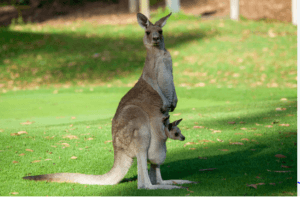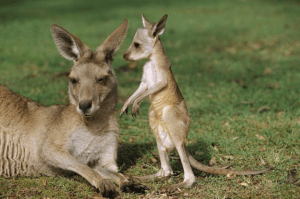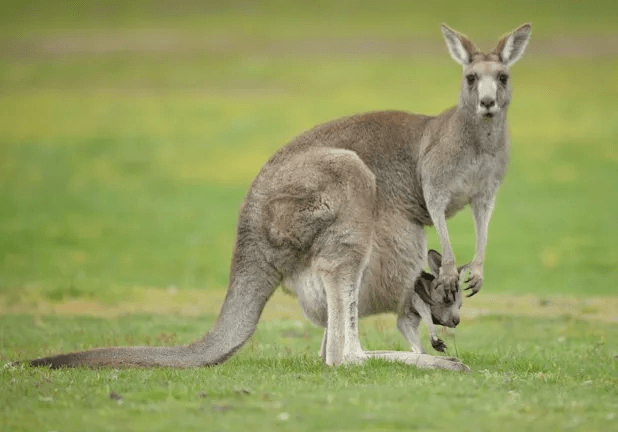Today, we’re going to answer all your queries related to Baby Kangaroo. A baby kangaroo is called a joey. How much time a joey stays in her mother’s pouch, what its activities are, what its size is, and a lot more are part of today’s article. So, read along and satisfy your knowledge tank about baby kangaroos.
Kangaroos Belong to the Group Marsupials- What is a Marsupial?
It’s a mammalian group that is recognised by the premature birth of their babies. The babies continue to develop while being attached to the nipples in the mother’s lower belly. ( Source Britannica)
More than 250 marsupial species are spread across the world. Some famous ones are Kangaroos, opossums, and koalas.
Now, let’s talk a little about the family of the Kangaroos. The family of kangaroos is known as Macropodidae, also known as Macropods. The literal meaning of macropods is “large foot”. Now, visualise a kangaroo, and you’ll remember that they have long feet. Some important family members of Macropods are:
- Kangaroos
- Wallaroos
- Wallabies
- Tree Kangaroos
- Pademelons
- Bettongs
- Quokkas
- Pottoroos
Interestingly, there are more than 50 unique Macropod species spread all over Australia and New Zealand.
What is a baby kangaroo called?

Baby Kangaroo
A baby kangaroo is called Joey. The joey at the time of birth is very small as compared to the rest of the mammals. It’s highly underdeveloped and embryo-like at the time of its birth.
The weight of a joey kangaroo is often related to the jellybean size because it’s literally that small. It makes the journey from its mother’s birth canal to the pouch by clambering up. Once the baby kangaroo safely reaches the pouch, it seeks nutrition and growth from its mother by feeding. The feeding details are different for different baby kangaroos or joeys and are discussed in the later section.
What’s the gestation period for a Kangaroo?
The gestation period for Kangaroo is up to 34 days.
What are the feeding details of the baby kangaroo, and when does Joey leave its mother’s pouch?
Usually, after six months, the body of a baby kangaroo is well-developed. At this stage, it leaves its mother’s pouch for a shorter time and returns when it needs food. Here is a little difference between the feeding details of red and grey baby kangaroos:
- The red baby kangaroo exits the pouch of its mother after eight months. It keeps suckling for 3-4 months.
- The grey baby kangaroo has a longer feeding time and stays more in its mother’s pouch than the red baby kangaroo. The grey joey exits the pouch of its mother after 11 months. It keeps suckling till the 18th month, meaning one and a half years.
Fortunately, nature is miraculous. The female kangaroos can feed two joeys at the same time, one baby kangaroo in the pouch and one outside of the pouch. It offers two types of milk to two joeys, depending on their needs. At the same time, it’s ready for egg implantation, too. Indeed, the female kangaroos have a tremendous reproductive system.
Everything You Need To Know About Baby Kangaroo in Pouch:
Kangaroos belong to the group marsupials, and though many species, such as opossums, Tasmanian devils, and even koalas, raise their babies in pouches, kangaroos are special and certainly more iconic.
The baby kangaroo in the pouch is very small. It’s less than a gram, and you can compare it to the size of a jelly bean. The baby kangaroo crawls with the help of its forelimbs and reaches its mom’s pouch.
Once in the pouch, it rushes onto a milk duct that swells and pokes down the throat of the baby. The baby kangaroo usually stays 4 and a half months in its mommy’s pouch.
After 4 and a half months, it emerges from its mother’s pouch and starts exploring the world. But, as it’s still a baby kangaroo, it stays close to its mother and frequently returns to its pouch.

baby kangaroo in pouch
Over the span of a few months, the baby kangaroo grows up a little and starts exploring distant places for a longer duration and probably after 8 months; it gets adventurous. After 10-12 months, the baby kangaroo doesn’t hop back into the pouch.
You might be wondering if the baby kangaroo stays in the pouch of its mother before emerging. Where does it defecate? Yes, you guessed right. It defecates inside the kangaroo’s pouch.
Later, during exploration, it starts defecating on the floor. But the mommy kangaroo has to clean its pouch for its babies!
Do Male Kangaroos Have Pouches?
You guessed right: male kangaroos don’t have pouches because they don’t have to feed baby kangaroos. Only female kangaroos have pouches to take care of their offspring.
What’s inside the pouch of a Kangaroo?
Obviously, it’s the baby kangaroo in the pouch of the kangaroo. You can imagine the Kangaroo’s pouch as a hoodie, and the drawstrings are the mother’s muscles, which the baby Kangaroo uses to open and close.
Here are some quick, interesting facts about the inside of a Kangaroo’s pouch:
- The inside of a Kangaroo’s pouch is the texture of its hairless skin.
- The inside of a kangaroo is as soft as the inside of a person’s wrist.
- Also, the pouch is very warm.
- The temperature of the Kangaroo’s pouch is 105° Fahrenheit or 40.5°C. Because of such a high temperature, the baby kangaroo sometimes gets sweaty inside the pouch.
- The Kangaroo pouch has four milk ducts to feed its joey.
Some Tidbits About the Reproductive Cycle of the Kangaroos:
The mommy kangaroo gave birth to only one baby, Joey, at a time. From just one mating, the female kangaroo can give birth to four or more baby kangaroos.
She can give birth to one joey, but her body delays implantation for a few months until the first baby kangaroo is a few months old and out of the pouch.
Surprisingly, the body and mechanisms of a female kangaroo are fascinating. She produces specialised milk for her baby kangaroos. She can produce suitable nutritional milk for an 8-month-old kangaroo from one milk duct, and the other test can create the right nutritional milk for a newborn kangaroo.
But, if the mate and the situation aren’t feasible to grow a baby inside the body of the female kangaroo, it can hold off on implanting the embryo into the uterus, especially in the seasons of droughts and extreme weather conditions. When the situation becomes feasible, the embryo comes out of the dormant stage. And the gestation period begins. And you know, the gestation period of kangaroos is only 32-34 days.

joey kangaroo
Another critical point to remember is that the female kangaroo usually doesn’t give birth from October to February because of winter and extreme weather.
More info: List of 25 Animals That Start With V 2024
Conclusion:
Kangaroos are beautiful animals, adding beauty to the wildlife. The way mommy kangaroo produces and takes care of its baby kangaroo is lovely and appreciative, and no matter what, mommy’s are mommy’s, even if we talk about animals.
We hope you got some fantastic knowledge regarding the baby kangaroo joey and its lifestyle. The baby kangaroo stays in its mom’s pouch until a few months (4-4.5 months) and then starts exploring the world.
The inside of the pouch is warm and hairless. Warm enough that the baby kangaroo may feel sweaty. The temperature of the Kangaroo’s pouch is 40.5°Celsius.
The female kangaroo can give birth to four baby kangaroos yearly. But it produces one Joey one time. And put the other joey on delay until the newborn joey grows up a little and gets out of the pouch. But it can delay implantation sometimes, especially in times of droughts and extreme weather conditions.
